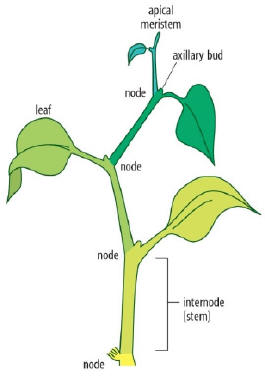
This is the second article in a series about botany for gardeners. I have always been in awe of the mystery of what goes on inside plants. Every winter I stare at my gardens with nothing showing and wonder just how the plants and seeds underground will return. Just as a human embryo develops specialized functions like a heart, a brain, a spine etc.
from cells, so does an embryonic seed sprout and develop roots, stems, leaves and flowers from specialized cells.
My first article about botany described the basic development of seeds and roots, including an understanding of tap roots. This article introduces stems and the functions of some of their unique cells.
The above ground part of a sprouted seed is the shoot system consisting of a plantís principal stems, branches and leaves. All of these arise from the main stemís apical meristem growing tip that makes the stem grow longer via cell division and initiates the orderly arrangement and development of stems and leaves. (See diagram of cell parts.)
This apical meristem cell bud at the tip of a main stem releases a hormone that prevents side buds from developing. If left untouched, the stem continues to grow longer without side branching. Removing that apical tip bud allows the side buds to develop into side shoots or branches. These very tiny buds can be seen with close-up viewing. Leaves
develop from these tiny buds.
 The side axiliary buds that get activated by pruning or "pinching back" form new stems leading to branching. Axiliary buds can be dormant for seasons or years waiting to spring into action, creating a new stem should the apical tip buds get pruned, destroyed by disease or animals.
Stems can be herbaceous, having soft, green tissue with little woody tissue, such as petunias or foxgloves or woody with dense outer "bark" tissue such as trees or shrubs.
The side axiliary buds that get activated by pruning or "pinching back" form new stems leading to branching. Axiliary buds can be dormant for seasons or years waiting to spring into action, creating a new stem should the apical tip buds get pruned, destroyed by disease or animals.
Stems can be herbaceous, having soft, green tissue with little woody tissue, such as petunias or foxgloves or woody with dense outer "bark" tissue such as trees or shrubs.
One of the stemís functions is supporting leaves in a way that captures the most sunlight for energy production via photosynthesis. As a stem grows, internodes stretch and spread the leaves and axillary buds apart to ensure each leaf gets maximum exposure to the sun and good air circulation. The arrangement of leaves on a stem, known as phyllotaxy,
takes one of three basic forms; alternate, opposite or whorled in a circle about the stem Shoots formed are capable of producing many branches; however, only a limited number are created at any one time.
When looking at soft-green new growth on a treeís stem, ever wonder how it becomes a woody tree trunk? Inside the stem are bundles of vascular tissues that transport water, minerals and food. The inner half of this vascular bundle contains the water-conducting cells called xylem from the Greek word for wood. Water is conducted only in an upward
direction. Toward the outside of the bundle are the food transporting cells called the phloem from the Greek word for tree bark.
Between these bundles is the vascular cambium tissue responsible for the sideways increased growth in diameter of a stem. Complicated changes in these vascular bundles form the interior "heartwood" support of a tree while providing transport of food and water and the formation of protective bark. Everyone has seen cross sections of tree trunks
where various growth rings are visible. Look closely at the rings and you can see these various sections.
No one knows precisely how this process of cell differentiation takes place. There are many unresolved mysteries in the developmental process in plants. The progress and success of a plantís growth are in response to the environment in which it is living. Adequate water, optimum temperatures, sunlight and food are just some of the variables that
affect growth and survival.
Plants have developed survival attributes to ensure their continued existence. Future botany articles will explore why and how plants respond to light, how they climb and twirl around a support, how they heal wounds, what are their defensive mechanisms for protection from attack by other creatures, and other fascinating botanical facts about the
plants in our yard and gardens.
Read -
More Botany for Gardeners